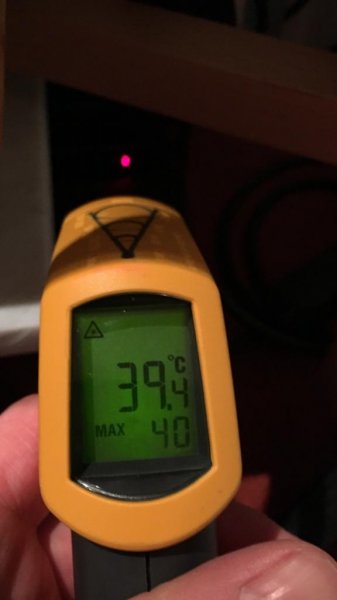@Adimon: It looks like you removed the picture of your rack - I was going to tell you that placing marble on top of the preamp and amp can be detrimental in the long run. Reason being that you are trapping the heat and that's not good. There is good reason why people use metallic damping plates to weigh things down (like HRS), and moreover, I actually have a high-end computer fan on top of the 30SV (see https://noctua.at/)
ack's system - end of round 1
- Thread starter ack
- Start date
You are using an out of date browser. It may not display this or other websites correctly.
You should upgrade or use an alternative browser.
You should upgrade or use an alternative browser.
@Adimon: It looks like you removed the picture of your rack - I was going to tell you that placing marble on top of the preamp and amp can be detrimental in the long run. Reason being that you are trapping the heat and that's not good. There is good reason why people use metallic damping plates to weigh things down (like HRS), and moreover, I actually have a high-end computer fan on top of the 30SV (see https://noctua.at/)
Yes the picture was bad quality.
Did you make a hole in the top plate for the Fan?
In my case there is space between the marble plate and the housing for airflow (the top plate is removed).
See picture (red circle):
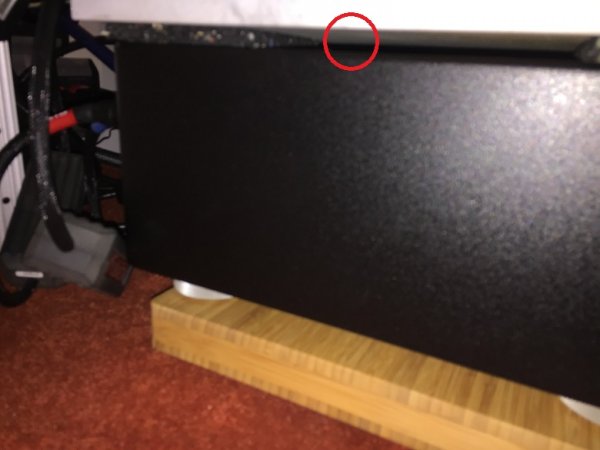
Well, no, I did not make a hole - the point here is that I don't have the requisite clearance on top, so a fan is necessary. I think you are choking your amp and preamp even if you have a gap as shown
Thx Blue58 i will try.
To reduce the ringing of the heatsinks like ack mentioned i put some isolation pieces between the cooling ribs.
To prevent cooling issues i did the following:
View attachment 38361
I've tried this same thing with Isodamp on my Innersound amps. The fins are much closer together than the picture above. The noise floor was definitely quieter, but it deadened the sound too much. Particularly the high frequencies. If I were designing an amplifier I would weld the end of the fins together in certain spots to reduce ringing. I suspect if one were to do that on an existing amp that the change in sound would require different parts choices to make the amp sound right.
Adimon, could you explain what you heard when you damped your amp heatsinks?
Last edited:
Hi Sean,
In my opinion Spectral is extremely sensitive for changes.
It is hard to mention but what i experience is a cleaner sound at high levels.
Also you hear more micro details for whatever that means.
But i have to listen longer and to more different kinds of music to make a defenitiv conlusion.
Till now it is hopeful.
In my opinion Spectral is extremely sensitive for changes.
It is hard to mention but what i experience is a cleaner sound at high levels.
Also you hear more micro details for whatever that means.
But i have to listen longer and to more different kinds of music to make a defenitiv conlusion.
Till now it is hopeful.
I've tried this same thing with Isodamp on my Innersound amps. The fins are much closer together than the picture above. The noise floor was definitely quieter, but it deadened the sound too much. Particularly the high frequencies. If I were designing an amplifier I would weld the end of the fins together in certain spots to reduce ringing. I suspect if one were to do that on an existing amp that the change in sound would require different parts choices to make the amp sound right.
Adimon, could you explain what you heard when you damped your amp heatsinks?
I've listened now a couple of days to several records.
The sound is absolutely cleaner, try for example Carole King Welcome to my Living Room or Willy Deville Live in Berlin.
The sometimes harsh sound is gone.
That's great. Here's an engineering guide around the EAR materials http://www.trelleborg.com/Documents...-for-Noise-Vibration-Shock-and-Cushioning.pdf and if you look closely on page 19, it looks like one can use the VersaDamp series of products for high temperature applications, with a maximum continuous operating temperature of 100C. The problem is sourcing Versadamp sheets at retail prices, and especially the V-2590 that I am interested in. C-1002 may also do, with a max continuous operating temperature of 70C.
Well, Adimon, you are a bad influence. So I am currently experimenting with Isodamp on the heatsinks, let's how well it holds up to the heat (currently at 41C, plenty of headroom till 70C):
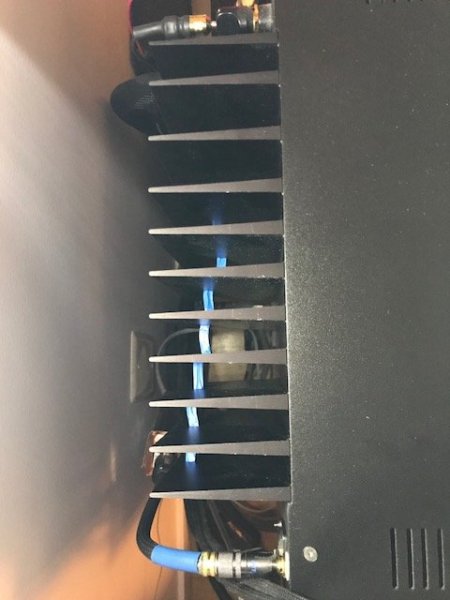
Don't mind the unevenness, I am experimenting with various "depths". I'll hold off on any sonic impressions for a little bit...

Don't mind the unevenness, I am experimenting with various "depths". I'll hold off on any sonic impressions for a little bit...
So the sonic effect of placing Isodamp between the fins has been profound. I've known about the heatsink ringing for years but never cared to experiment, and this discussion has been well worth it. There appears to be a narrow band of frequencies where the resonance is more pronounced, and the Isodamp takes care of that. The decrease in distortion is evident at high volumes with trumpets, treble piano notes, and soprano, and perhaps other instruments I have not played. But there is definitely less zinginess when going loud, which may sound pleasing at times but it's a distortion and not natural.
This has me wondering about the DMA-500/Magico M3 again, in the sense that perhaps part of what I am hearing at the dealer is slightly distorted treble w/ some exaggeration due to these vibrations, and because of the M3's apparent high resolution, the problem is more evident.
Regardless, the goal here is to add two pieces of Isodamp per gap, in vertical configuration as shown... Fascinating results, to be honest.
This has me wondering about the DMA-500/Magico M3 again, in the sense that perhaps part of what I am hearing at the dealer is slightly distorted treble w/ some exaggeration due to these vibrations, and because of the M3's apparent high resolution, the problem is more evident.
Regardless, the goal here is to add two pieces of Isodamp per gap, in vertical configuration as shown... Fascinating results, to be honest.
So the sonic effect of placing Isodamp between the fins has been profound. I've known about the heatsink ringing for years but never cared to experiment, and this discussion has been well worth it. There appears to be a narrow band of frequencies where the resonance is more pronounced, and the Isodamp takes care of that. The decrease in distortion is evident at high volumes with trumpets, treble piano notes, and soprano, and perhaps other instruments I have not played. But there is definitely less zinginess when going loud, which may sound pleasing at times but it's a distortion and not natural.
This has me wondering about the DMA-500/Magico M3 again, in the sense that perhaps part of what I am hearing at the dealer is slightly distorted treble w/ some exaggeration due to these vibrations, and because of the M3's apparent high resolution, the problem is more evident.
Regardless, the goal here is to add two pieces of Isodamp per gap, in vertical configuration as shown... Fascinating results, to be honest.
Interesting results guys, It's been some time since I tried this on my amps. I'm in a different room now and have some different wires and equipment now. Maybe I will try it again. My amps don't get very hot so I'm not worried about the isodamp melting.
Go ahead Sean!
Meantime, back to the Telarc Carmina Burana LP... I am taking the liberty to quote the following from the recent VPI Titan review on monoandstereo published today(?), and I couldn't have said it better myself http://www.monoandstereo.com/2018/0...ml?utm_source=dlvr.it&utm_medium=facebook&m=1
Meantime, back to the Telarc Carmina Burana LP... I am taking the liberty to quote the following from the recent VPI Titan review on monoandstereo published today(?), and I couldn't have said it better myself http://www.monoandstereo.com/2018/0...ml?utm_source=dlvr.it&utm_medium=facebook&m=1
I shall end this review with Carl Orff’s magnum opus, the Carmina Burana, [...] I’ve pulled out the 1981 Telarc recording, with Robert Shaw directing the Atlantic Symphony Orchestra (Telarc 10056/57 1981 German Pressing) and played it with the tonearm, cartridge, and cartridge/drive mechanism combination which I found most favourable on the Titan turntable.
Using the Graham Phantom II Supreme B52 12" arm, the Clearaudio Goldfinger Statement cartridge, and the Belt Drive, I’ve heard one of the most satisfying reproductions of this album ever. The sheer dynamic power and scale of the full orchestra demand every ounce of energy from the equipment.
The strength of the chorus combined with an earth-shattering bass drums drove my 1000 watts bi-amped McIntosh MC3500 amplifiers into clipping territory, yet the VPI Titan didn't even flinch. On a lesser turntable the orchestral sound will get disorganized and the chorus will be garbled up. The Titan sailed effortlessly through the most difficult and complex passages with ease and reproducing a majestically powerful sounding orchestra in my listening space. Make no mistake about it, this is a turntable for the big boys!
Well, Adimon, you are a bad influence. So I am currently experimenting with Isodamp on the heatsinks, let's how well it holds up to the heat (currently at 41C, plenty of headroom till 70C):
View attachment 38400
Don't mind the unevenness, I am experimenting with various "depths". I'll hold off on any sonic impressions for a little bit...
U might pay attention to ur speaker banana plugs. Imagine all the micro vibration going on inside that binding post cylinder.......Spades are the only secure connection
U might pay attention to ur speaker banana plugs. Imagine all the micro vibration going on inside that binding post cylinder.......Spades are the only secure connection
+1...and they need periodic re-tightening
Nice. Any problems will show up in the summer. I actually just installed two computer fans under each amp's fins, so should be OK. I have not gone above 50C at typical listening levels, which will probably jump to 60 in the summer. Still, damping is less effective above 37C according to the C-1002 specs, and one should really get C-1100 that dampens up to 63C - but hard to find at retail prices.
I never use bananas, only spades
Sorry looks like bananas in ur picture
Sorry looks like bananas in ur picture
You are not wrong - I have banana jumpers to bypass the external part of my custom woofer crossover, if I need to... rarely used, and for testing purposes only.
UPDATE on the fans: they are keeping the temperature at 35C, and the amps have been playing all day - this is great. Go get some Noctua computer fans (exceptionally quiet with extremely high reliability) and an adjustable DC power supply.
I now no longer care for suspended turntables
Here's a rather boring picture of my VPI's feet - I have to raise the back a little in order for the table to be flat (uneveness in the floor underneath):
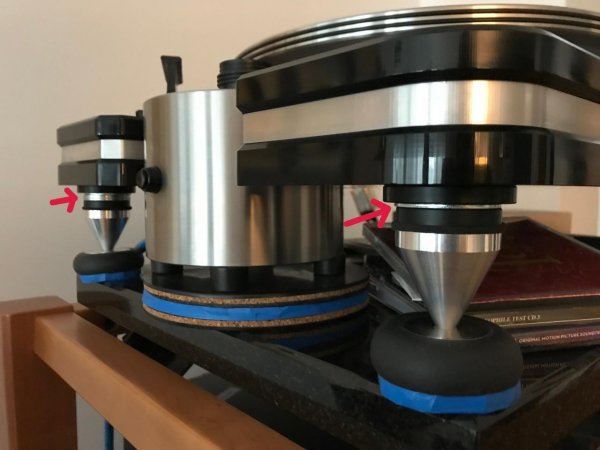
So for years, I was simply adjusting the feet, as anyone would, by unscrewing them, and said feet would be a bit loose after a certain point. What is interesting about that picture are those shiny washers, which enable me to actually tighten the feet really hard and maintain the height I need. For years, I could not understand why the bass would be a little slow and fat, and the midrange a little smeared, at least when comparing to HDCD (e.g. the Janaki Debut). It was not as bad as some suspended turntables where I've heard the bass drum bloom follow literally half a second or more post impact, but still not right.
A simple test would provide the solution: crank up the preamp all the way - ~100dB gain - and hard tap on the turntable base or platter; with the loose feet, there would be delayed feedback from the subwoofer as well as chaffing; once the feet were tightened, the feedback is gone. I don't know why it took me so long to realize this, but suffice it to say, I no longer care for suspended turntables. It is remarkable now how close the Janaki LP and HDCD sound, down to the drama of the shredded violin in one track. It is equally remarkable how detrimental micro-movements can apparently be.
Finally, FWIW, here are the Isodamp strips between the amp fins and the Noctua fan underneath.
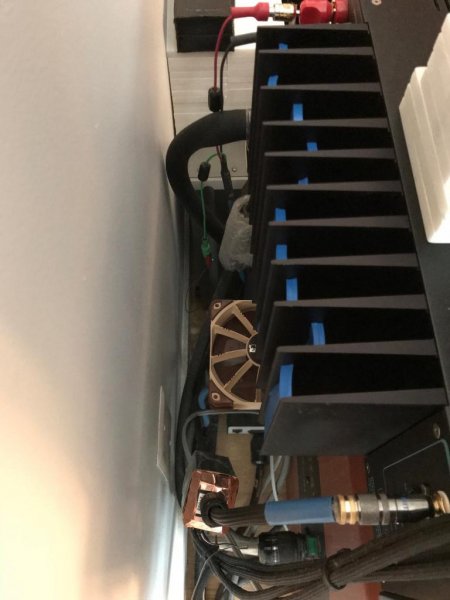
Here's a rather boring picture of my VPI's feet - I have to raise the back a little in order for the table to be flat (uneveness in the floor underneath):

So for years, I was simply adjusting the feet, as anyone would, by unscrewing them, and said feet would be a bit loose after a certain point. What is interesting about that picture are those shiny washers, which enable me to actually tighten the feet really hard and maintain the height I need. For years, I could not understand why the bass would be a little slow and fat, and the midrange a little smeared, at least when comparing to HDCD (e.g. the Janaki Debut). It was not as bad as some suspended turntables where I've heard the bass drum bloom follow literally half a second or more post impact, but still not right.
A simple test would provide the solution: crank up the preamp all the way - ~100dB gain - and hard tap on the turntable base or platter; with the loose feet, there would be delayed feedback from the subwoofer as well as chaffing; once the feet were tightened, the feedback is gone. I don't know why it took me so long to realize this, but suffice it to say, I no longer care for suspended turntables. It is remarkable now how close the Janaki LP and HDCD sound, down to the drama of the shredded violin in one track. It is equally remarkable how detrimental micro-movements can apparently be.
Finally, FWIW, here are the Isodamp strips between the amp fins and the Noctua fan underneath.

Last edited:
Here's a rather boring picture of my VPI's feet - I have to raise the back a little in order for the table to be flat (uneveness in the floor underneath):
So for years, I was simply adjusting the feet, as anyone would, by unscrewing them, and said feet would be a bit loose after a certain point. What is interesting about that picture are those shiny washers, which enable me to actually tighten the feet really hard and maintain the height I need. For years, I could not understand why the bass would be a little slow and fat, and the midrange a little smeared, at least when comparing to HDCD (e.g. the Janaki Debut). It was not as bad as some suspended turntables where I've heard the bass drum bloom follow literally half a second or more post impact, but still not right.
A simple test would provide the solution: crank up the preamp all the way - ~100dB gain - and hrds tap on the turntable base or platter; with the loose feet, there would be delayed feedback from the subwoofer as well as chaffing; once the feet were tightened, the feedback is gone. I don't know why it took me so long to realize this, but suffice it to say, I no longer care for suspended turntables. It is remarkable now how close the Janaki LP and HDCD sound, down to the drama of the shredded violin in one track. It is equally remarkable how detrimental micro-movements can apparently be.
Finally, FWIW, here are the Isodamp strips between the amp fins and the Noctua fan underneath.
Ack, are you checking the table plinth for level, or the platter? Do they match? I used to have a Zoethecus rack and abandoned it in favor of something much more solid. At the time I simply put shims under the shelf supports to level each individual shelf. If your floor underneath is uneven, why not just put a hard shim under your rack footers so that the rack itself and the individual shelves are level and be done with it? Then you could screw down your VPI footers. I would want to remove all of those washers and tighten the feet as much as possible for as solid a connection as possible so that internal vibrations drain away from the plinth. However, by putting the spikes up on dampening material, the vibrations are probably remaining in the footer/plinth structure anyway. Have you tried a rigid coupling of your turntable to the Zoethecus top shelf or to what looks like a marble slab?
I did not know that your VPI turntable is suspended. Or are you saying it acts like it is suspended because of the compliant rubber under each footer? Could you describe the suspension system and what specifically you do not like about it? I don't see how the leveling of the footers relates to your aversion to suspended turntables? I don't follow your conclusion or why you are constantly adjusting your table's feet? Is the level really changing that much over time? That's a lot of washers jammed in there. And could you further explain why you now don't like suspended turntables as a class? The Kronos, TechDas, SME are all suspended. Do they have these issues that you don't like or is it just about the implementation of your specific VPI turntable, which admittedly, I don't really understand?
Regarding your Isodamp, have you considered separating your electrical panel from its support structure with a layer of Isodamp to reduce vibrations? I don't know if this would violate local codes, but it might reduce noise in your power delivery system. I don't know if anyone has tried such a thing, but given your willingness to experiment with Isodamp, I thought I would throw out the idea to see what you think.
The Isodamp in the amp fins looks good and I bet the ringing has really decreased? Do you hear a difference? My Pass amps suffer from the same issue.
Similar threads
- Replies
- 21
- Views
- 14K
| Steve Williams Site Founder | Site Owner | Administrator | Ron Resnick Site Owner | Administrator | Julian (The Fixer) Website Build | Marketing Managersing |


